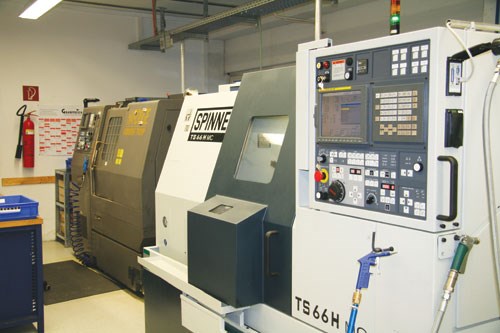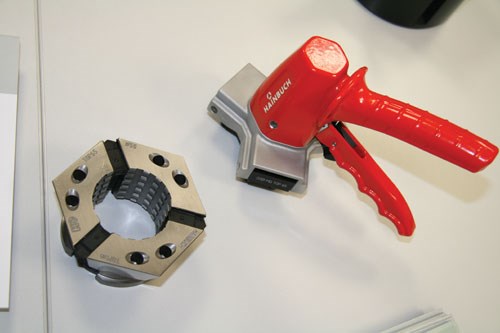The Right Clamp Makes a Difference
Clamping has often proven to be the Achilles heel of hard machining.
Clamping has often proven to be the Achilles heel of hard machining. This held true for tool manufacturer Becker Diamantwerkzeuge GmbH, of Landsberg, Germany, until the company started using the TOPlus clamping system from Hainbuch.
Although 1987 is the official year that Becker was founded, the firm’s origin goes back to the first half of last century. At that time, one of its primary activities was the manufacturing of diamond drawing dies. After the advent of polycrystalline diamond (PCD) and later cubic boron nitride (CBN), the firm was considered to be one of the pioneers in the area of ultra-hard cutting materials. At that time, metalcutting applications were fairly scarce, so the primary market was the jewelry industry.
In the mid 1970s Werner Becker left the family business and moved to Bavaria to start his own company. Although initially concentrating on natural diamond cutting tips, he recognized other possibilities associated with the use of these ultra-hard cutting materials.
“For more than 35 years we have been involved with the development, production and sales of precision metalcutting tools made of materials such as natural diamond, synthetic diamond and cubic boron nitride,” Mr. Becker says. “Several years ago these were still considered exotic cutting materials; today, we are talking about a market volume of approximately $2 billion. And in my opinion this is just the beginning.”
He adds, “It’s no longer just applications in the areas of precision and ultra-precise machining. Today, we have a variety of plate types with optimized cutting angles combined with our extremely wear-resistant, ultra-hard cutting materials that can increase productivity, and the quality of the products, significantly.”
Technically, the use of diamond cutting tips is relatively problem free, often only limited by the capacity of the machine. However, machining with CBN does require some experience and skill. Roland Kreuzer, director of application technology at Becker, says, “When using CBN, all relevant process parameters such as cutting values, feeds and clamping depths must be precisely determined in order to exploit the performance capabilities of the cutting material.”
Mr. Becker adds that results that are achievable in theory are often not achieved—and not achieved by a wide margin—because of poor general setup. To really exploit the strengths of the CBN cutting material—for example, during hard turning—the company needs a rigid total system. “Whomever works with unstable machine conditions with the wrong tool system, unsuitable cutting data, and/or uses CBN tools with the wrong clamping system, is simply throwing money out the window.”
Mr. Kreuzer says, “In this regard, it is primarily the right chuck that plays a crucial role. For our own hard-turned parts as well as customer trials and demonstration purposes, we rely on the TOPlus chuck from Hainbuch.”
Mr. Kreuzer recalled that the first thing he noticed about the TOPlus chuck was its hexagon shape. “We have machined identical parts with the same cutting parameters and only changed the chuck,” he says. “The result was so clear that even the manufacturing specialists at Becker were surprised. “We achieved a 50-percent increase in tool life right away, and this was achieved with significantly better surfaces.”
Mr. Becker adds, “With hard turning, the tool edge is subjected to pressure of as much as 70 kg, which can produce bending movement. Under that force, the chuck cannot give. Because of the hexagon pyramidal shape of the clamping head, there is no gap between head and clamping receptacle, which makes our TOPlus chuck resistant to fouling and even the smallest of chips. Not to mention the fact that process reliability is significantly increased.”
In the hard turning environment, the fact that these clamping systems ensure a continuously reliable manufacturing process is key. The crucial factor for surface quality and tool life is the chuck design. The chuck must be so rigid that pressure does not affect it.
“TOPlus has planar support and thus sliding friction,” says Joerg Tittel, Hainbuch regional sales manager. “Thanks to the large-surface support of the clamping segments, the hexagon is much more rigid, and, for the most part, remains vibration-free. This is also why higher cutting values can also be run with the clamping system without sacrificing tolerances on the workpiece and the tool life of the blades. As opposed to conventional taper collet chucks, in this case, there is no radial offset, which means that even under stress, if a bending occurs, the chuck cannot give.“
The clamping system offers other advantages as well as hard turning. Mr. Tittel referred to a customer that machines hexagon material for hydraulic connections 24 hours a day. In one work step, a workpiece with the corner dimensions of 32 mm on a length of 22 mm is machined to a diameter of 19 mm. With the previous clamping system, because of the interrupted cut, he had an annual consumption of more than 50 cutoff tools because he had to run full clamping pressure. In addition, he broke two drawtubes. With TOPlus, the customer was able to reduce the clamping pressure by 25 percent and virtually double the feed, which resulted in a savings of 3 seconds per rough machining process.
In spite of the significant reduction in machine time, since installing TOPlus, not one cutoff tool had been destroyed, and the tool life of the plates had increased four times. “We calculated what the customer saves with this machining step alone,” Mr. Tittel says. “At 120,000 parts per year, he saves 360,000 seconds. At machine costs of approximately 1.4 cents per second, the customer saves more than 5 cents per part. This equals approximately $6,000 annually. And bear in mind that is just with one work step.”
Mr. Kreuzer says, “The TOPlus is the ideal clamping device for our manufacturing, as well as for our trials. With our status today, I would say it doesn‘t get any better than this.”
Related Content
Data Matrix Codes Offer Cutting Tool Traceability
A company’s quest to discover errors in a manufacturing process has led to printing data matrix codes on its cutting tools that provide a wealth of information for both the user and this cutting tool manufacturer.
Read MoreThe Value of Swiss-Types Milling Rectangular Medical Parts
High-speed spindle technology was key to effective milling of small cardiac monitoring components complete on a CNC sliding-headstock machine platform instead of running them across two mills.
Read MoreParting Off: The Case for Standardizing on Sawing
The value of rotary saw cutting for parting off operations could boil down to simple economics paired with process efficiency gains.
Read MoreMaking Micro Threads
Production of micro threads can be challenging, but using the most suitable tools for a given application can simplify the task.
Read MoreRead Next
Change This Chuck: Save Setup Time
Quick change workholding is one way shops are reducing setup when dealing with higher-mix/ lower-voulme work.
Read MoreEmerging Leaders Nominations Now Open
Here’s your chance to highlight a young person in your manufacturing business who is on the path to be a future leader moving your company forward.
Read More5 Aspects of PMTS I Appreciate
The three-day edition of the 2025 Precision Machining Technology Show kicks off at the start of April. I’ll be there, and here are some reasons why.
Read More

















.png;maxWidth=300;quality=90)







